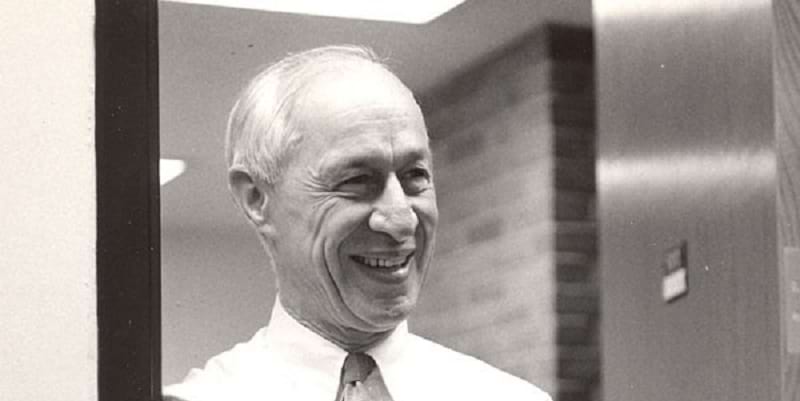Rensis Likert biography and theory

Rensis Likert (August 5, 1903 – September 3, 1981) was an American organizational and social psychologist best known for his contributions to psychometrics, the study of organizational behavior, and management theory. Rensis Likert is also known for the Likert scale, a psychometric tool he developed to quantify responses to surveys, for example, and his pioneering work in the field of participatory management.
The biography of Rensis Likert
Rensis Likert was born in Cheyenne, Wyoming. He was the son of George Herbert Likert and Cornelia Adrianna Likert. His father was an engineer who worked for the Union Pacific Railroad, and mother Cornelia was a former teacher. Rensis had 1 younger brother, who bore the same name as his father George.
The family moved to different states when Rensis was a child. He completed his high school education in Kansas, Utah and Nebraska. At the suggestion of his father, he studied civil engineering at the University of Michigan in 1922.
During that time he worked as an intern at the Union Pacific Railroad. A strike among railway workers aroused his interest in organizational behavior there. The poor communication between workers and management had a major impact on Likert and determined the course of his future career.
Study
In the final year of his studies in civil engineering, he changed his field of study to sociology and economics. He did so at the suggestion of Professor Robert Angell, who remembered Rensis as one of the most brilliant engineering students. Likert went on to earn a B.A. in sociology in 1926.
Likert was an active student and participated in various student activities at the university. He was a member of several student organizations, served as vice president of the Michigan Union, and chaired the cabinet of the Student Christian Association.
After graduation, Rensis Likert studied theology at Union Theological Seminary for a year and received his Ph.D. in psychology from Columbia University in 1932. While studying here, he became interested in the emerging discipline of social psychology. In 1938 he published his first book, Public Opinion and the Individual, with his mentor Gardner Murphy.
In the 1930s, he left the world of academics for public service and became head of the Division of Program Surveys for the Bureau of Agricultural Economics of the U.S. Department of Agriculture. In 1935 he stepped into the role of Director of Research for the Life Insurance Agency Management Association (LIAMA) in Connecticut.
Personal life
While at Columbia University, Rensis Likert married Jane Gibson. The two had met at the University of Michigan. The couple had two daughters: Elizabeth and Patricia. In 1969, Rensis Likert retired as director of the Institute for Social Research. The couple moved to Honolulu, Hawaii, where they founded Rensis Likert Associates. Likert died of cancer on September 3, 1981 in Ann Arbor, Michigan, at the age of 78.
Contributions
Rensis Likert is best known for his work in organizational behavior and management theory. He is considered a pioneer of participative management, emphasizing employee involvement in organizational decision-making processes.
His most well-known and widely used contribution to psychometrics is the development of the Likert scale. The Likert scale is used to measure and quantify people’s attitudes and opinions. The scale consists of a series of statements to which participants can respond with answers such as:
- Strongly agree
- Agree
- Neutral
- Disagree
- Strongly Disagree
This scale is still widely used today in various fields of research, including psychology and marketing.
Likert has also made important contributions to organizational structures and leadership styles. He introduced the concept of the System 4 Model, or the Likert Management System, which identifies four different organizational levels based on employee participation and involvement:
- System 1: Exploitative Authoritative
- System 2: Benevolent Authoritative
- System 3: Consultative System
- System 4: Participative System
According to Likert, an organization can only function at the highest level if there is a high degree of participation and trust between employees and management.
While Likert received much recognition for his contributions during his lifetime, his work continued to inspire and influence many after his death. His ideas and models remain relevant in the modern world and have helped shape the understanding of effective leadership and organizational behavior.
Famous quotes
- “[Each person] is a member of one or more functioning workgroups that have a high degree of group loyalty, effective skills of interaction, and high-performance goals.”
- “[It remains to be seen whether the newer management theories, based as they are on research in industrial concerns, will be] equally applicable to other kinds of organized human activity, such as schools, voluntary organizations, unions, hospitals, governmental agencies, scientific and professional organizations, and the like.”
- “A variety of studies in widely different fields show that supervisors who are getting the best production, the best motivation, and the highest levels of worker satisfaction are employee-centered appreciably more often than production-centered.”
- “All component parts of any system of management must be consistent with each of the other parts and reflect the system’s basic philosophy.”
- “As people acquire more education, their expectations rise as to the amount of responsibility, authority, and income they receive.”
- “As tasks become more varied and require greater training and skill, the relationship (between job attitudes and performance) appears to change progressively from the negative to positive.”
- “Conflict is viewed as the active striving for one’s own preferred outcome which, if attained, precludes the attainment by others of their own preferred outcome, thereby producing hostility.”
- “How best to organize the efforts of individuals to achieve desired objectives has long been one of the world’s most important, difficult, and controversial problems.”
- “Interaction and decision making relies heavily on group processes.”
- “Research reveals that managers achieving better performance (i.e., greater productivity, higher earnings, lower costs, etc.) differ in leadership principles and practices from those achieving poorer performance.”
- “The leadership and other processes of the organization must be such as to ensure a maximum probability that in all interactions and all relationships with the organization each member will, in the light of his background, values, and expectations, view the experience as supportive and one which builds and maintains his sense of personal worth and importance.”
- “The superior in one group is a subordinate in the next group, and so on through the organization.”
- “To be effective in leading his own work group, a superior must be able to influence his own boss, that is he needs to be skilled both as a superior and as a subordinate.”
Books and Publications by Rensis Likert et al.
- 1955. New Ways of Managing Conflict.
- 1954. The Human Organization: Its Management and Value. American Sociological Review.
- 1952. The sample interview survey: A fundamental research tool of the social sciences.
- 1951. Some Applications of Behavioural Research.
- 1950. New Resources for Improving School Administration.
- 1949. Some Applications of Behavioural Research.
- 1948. A Method for Coping with Conflict in Problem-Solving Groups.
- 1946. System 4: A Resource for Improving Public Administration.
- 1945. Effective Supervision: An Adaptive and Relative Process.
- 1944. Some applications of behavioral research.
- 1943. Public opinion and the individual: a psychological study of student attitudes on public questions, with a retest five years later.
- 1942. Some Applications of Behavioral Research.
- 1941. Kurt Lewin A Pioneer in Human Relations Research.
- 1940. New Patterns of Management. Industrial and Labor Relations Review
- 1939. New ways of managing conflict.
- 1937. From production-and employee-centeredness to systems 1-4. Journal: Journal of Management, 5(2), 147-156.
- 1936. The Human Organization: Its Management and Value. Industrial and Labor Relations Review.
- 1936. Organizational theory and human resource accounting. Journal: American Psychologist, 24(6), 585.
- 1935. The Human Organization: Its Management and Value.
- 1935. Public opinion and the individual: A psychological study of student attitudes on public questions, with a retest five years later.
- 1934. New Patterns of Management. Social Forces.
- 1934. A simple and reliable method of scoring the Thurstone attitude scales. Journal: The Journal of Social Psychology, 5(2), 228-238.
- 1933. The human organization: its management and values.
- 1932. A technique for the measurement of attitudes. Publisher: Archives of Psychology.
How to cite this article:
Janse, B. (2023). Rensis Likert. Retrieved [insert date] from Toolshero: https://www.toolshero.com/toolsheroes/rensis-likert/
Original publication date: 06/21/2023 | Last update: 07/19/2023
Add a link to this page on your website:
<a href=”https://www.toolshero.com/toolsheroes/rensis-likert/”> Toolshero: Rensis Likert</a>











